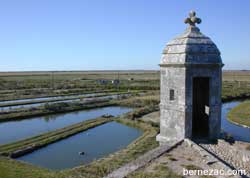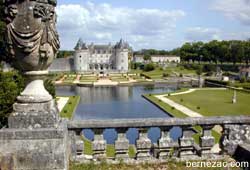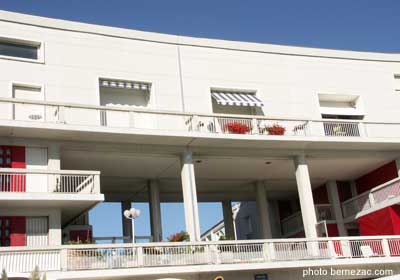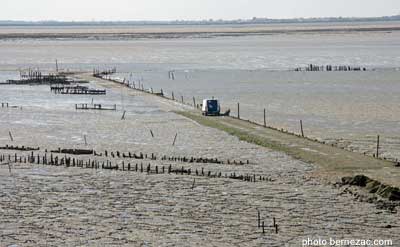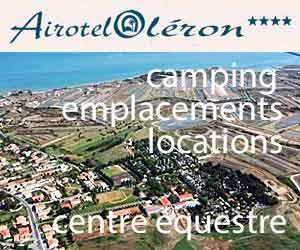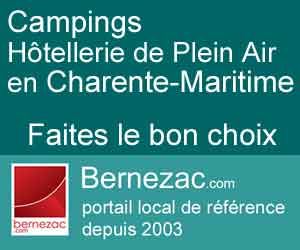BERNEZAC.COM / TO KNOW
Monumental Heritage, Maritime Heritage, Landscape Heritage
Romanesque Art
 Romanesque Art, the region bears a rich testimony to the religious art of the 11th and 12th centuries. After the year one thousand, hundreds of churches were built, in particular on the roads of Santiago de Compostela. This construction was started in the 11th century and continued in the 12th century. The limestone which is easy to work with, aided the creativity and the skill of the masons and the sculptors.
Romanesque Art, the region bears a rich testimony to the religious art of the 11th and 12th centuries. After the year one thousand, hundreds of churches were built, in particular on the roads of Santiago de Compostela. This construction was started in the 11th century and continued in the 12th century. The limestone which is easy to work with, aided the creativity and the skill of the masons and the sculptors.
> to know more about Romanesque Art in Charentes and Poitou
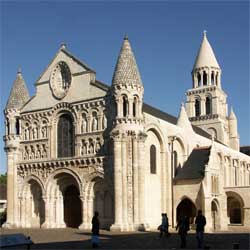 The Notre-Dame-la-Grande church of Poitiers, masterpiece of Romanesque art from the 11th and 12th centuries with its sculpted facade is unique.
The Notre-Dame-la-Grande church of Poitiers, masterpiece of Romanesque art from the 11th and 12th centuries with its sculpted facade is unique.
> discovery tour of Notre-Dame-la-Grande
> the polychromes of Notre-Dame-la-Grande
The abbey of Sablonceaux, a remarkable range of architectures from the 12th to the 18th centuries, twenty kilometers from Royan, in the countryside in the heart of the Romanesque Saintonge, offers a haven of peace to people who wish to escape from the animation of the beaches.
> to know more about Sablonceaux Abbey
For lovers of Romanesque art, heritage, for lovers of cultural and artistic events, the Abbey of Trizay, a medieval monastic complex remarkably restored, is a destination that counts, in summer as in the rest of the year .
> find out more about Trizay Abbey
 The Saint-Eutrope church of Saintes
The Saint-Eutrope church of Saintes
This Romanesque church was built from 1081 by the monks of Cluny, around the tomb of Saint Eutrope, first bishop of Saintes. On the way of Santiago de Compostela.it was designed as a large pilgrimage church with an exceptional plan for the Saintonge.
> find out more about Saint-Eutrope Church
The Abbaye de Fontdouce is located in an area combining forests, meadows and vineyards. Near Saintes and Cognac, 45 minutes from Royan. Abbaye de Fontdouce has become over the years a very active tourist and cultural site.
> find out more on the abbaye of Fontdouce
Archaeological sites
The Fâ site in Barzan
The Archaeological Site of Fâ, in Barzan, 2 km from Talmont, an extraordinary discovery of aerial archeology and constant efforts to highlight and explain to the public the past.
> find out more on the Fâ website
Ancient city of Mediolanum Santonum, the amphitheater, better known as "Arenes de Saintes", is located to the north, a bit away from the city. The Arch of Germanicus was built around 18-19 AD by Caius Julius Rufus, a notable santon, erected at the entrance to the now-defunct Roman bridge, dedicated to Tiberius, Drusus and Germanicus.
> to know more about Gallo-Roman Saintes
Coastal fortifications
Fort Boyard
A silhouette familiar to all regulars stays in the island of Oléron or on the continent of Charente. & Nbsp; Television allows us for some years, to discover the interior architecture on the occasion of the television game Fort Boyard. So many reasons to visit Fort Boyard more closely.
Brouage, Grand Site National, the discovery of Brouage, the meeting of Saintonge and Quebec. The ramparts of Brouage, built from 1630 to 1640, typical example of the fortifications of the early 17th century, announcing the fortifications of Vauban.
The Vauban sites on the UNESCO World Heritage List
The network of Vauban's major sites was added to UNESCO's World Heritage List at the July 7, 2008 meeting of this organization held in Quebec City. For our region, the citadel of Saint-Martin-de-Ré, the citadel of Blaye with Fort Paté on the estuary and Fort Médoc in Cussac, constituting the three locks of the estuary, are among the twelve major sites selected .
At the time of Vauban, the artillery becomes more powerful. Cities become strongholds. The enclosure and citadel of Saint-Martin-de-Ré are often described as "the most beautiful example of an island dweller". This is the first Vauban system adapted to a plain site.
> to know more about Vauban on the island of Ré
 Vauban and the protection of Rochefort
Vauban and the protection of Rochefort
Vauban and the protection of Rochefort. The new town of Rochefort created by Colbert, the new port and the arsenal are from 1666 major elements of the military strategy of the 17th century.
> to know more about Vauban and Rochefort
In Blaye, the limestone cliffs fall steeply over the Gironde estuary. The hill of Blaye is already fortified when Vauban arrives at Blaye in 1685. The objective is to protect Bordeaux against any invasion. Blaye has throughout its history, occupied a strategic position, "lock of the estuary", "sentinel of Bordeaux"
> to know more about Vauban in Blaye
The lighthouses of Charente-Maritime and Gironde estuary

An opportunity to visit a lighthouse? Do not miss it, provoke it, you will not regret the little effort necessary to climb the steps that lead to the summit and the superb panoramas.
The visit of a lighthouse is not only an opening to the sea but also a look at the history of navigation and men who have allowed progress.
The need for the navigator to recognize the coast at night as well as daylight led to the construction of lighthouses and the development of remarkable points.
> discover the lighthouses of the islands and coastline
The castles
The Castle and gardens of La Roche-Courbon
In the heart of the Saintonge, an enchantment, a fairy tale, a few kilometers from the coast, beautiful images of stones, greenery, water in the brightness characteristic of the Charente sky.
> find out more about Château de La Roche-Courbon
Seaside architecture
Royan and the seaside architecture of the 1950s
A "laboratory of modern urbanism and architecture", has been used to characterize the methods and work of the architects and urban planners at the time.
> to know more about the reconstruction of Royan
Royan "Belle Epoque"
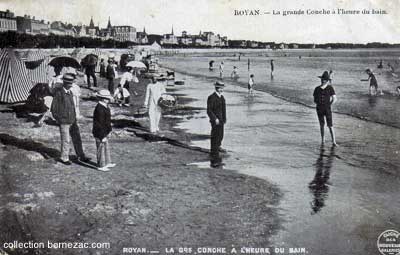 Royan, from the sea baths fashion to the 39-45 war
Royan, from the sea baths fashion to the 39-45 war
In a century and a half, the borough of Royan is experiencing extraordinary development taking full advantage of the opportunities offered by the evolution of lifestyles and economic and technical progress.
> all about Royan and the Belle Epoque
The marshes
The Marais Poitevin
We are talking about wet marshes, desiccated marshes, marine marsh, green Venice. The Poitevin marshes spread from Niort in the Deux-Sèvres, to the Bay of the Aiguillon in Vendée, making a small detour through the Charente Maritime. The part between Niort and Maillé is nicknamed The Green Venice.
> learn more about the Marais Poitevin
Ten kilometers in the marsh of Brouage on a little road that is worth the detour. More than 150 species of birds frequent the Brouage Marshes.It is a nesting place, gray herons, purple herons, egrets. As for the white storks, they have been nesting there since 1978.
The forests
The forest of La Coubre
La Coubre forest covers more than 5,000 hectares along the coast of the peninsula of Arvert. This space, which seems to us natural today, is born of the will of men. This forest of maritime pines was indeed planted in the 19th century to contain the advance of the sands.
discover the forest of La Coubre
The "Carrelets"
"carrelet" fishing
A "carrelet" is a hut for fishermen. Built of wood on piles and standing with feet in the water, it is linked to the cliff by a pontoon. The big square net, suspended from a mast, is lowered and raised by means of a winch with a counterweight. One finds ‘carrelets’ along the estuary of the Gironde and on the coast of Charente.
discover the carrelets of Charente-Maritime and estuary of Gironde
Oyster farming and mussel farming
Oyster farming
Many books and magazines describe the world of oyster farming. It is much more interesting and alive if we try to understand its essential by visiting the producing localities and talking with oyster farmers.
The northern coast of Charente-Maritime and the Bay of Aiguillon are the main area for mussel farming (mussel farming). Charron, the northernmost village in the department gave its name to a brand of mussels "La Charron".






